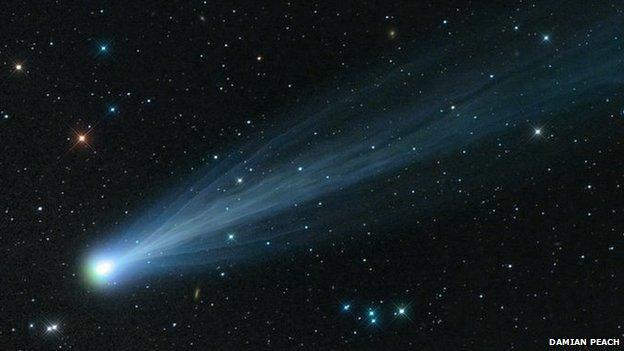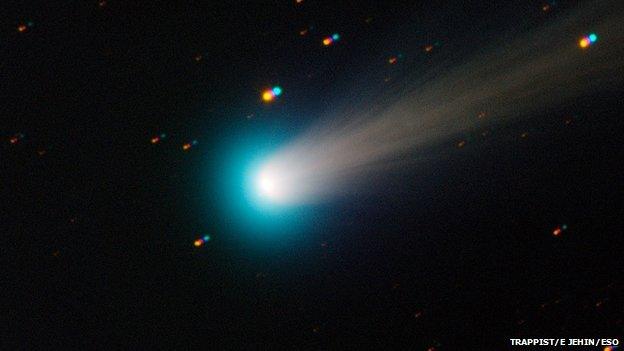Comet Ison brightens, but no fireworks so far
- Published

This stunning photo was taken by astrophotographer Damian Peach with a 20cm telescope on 15 November
Astronomers are getting good views of Comet Ison, but the icy object has not yet lived up to the high expectations set for it.
Ison has been brightening over the last two weeks, letting rip two giant outbursts of gas and dust.
But it has not yet produced the spectacular sky show some had predicted.
The comet is currently hurtling towards the Sun and is set for its closest approach on 28 November.
Ison might not survive its encounter with the Sun, but if it does, it could yet delight stargazers with a dazzling display.
A BBC Horizon special about the comet will be screened on Saturday.
A photo taken by astrophotographer Damian Peach on 15 November showed many separate streams inside the dusty tail.

Two wing-shaped features have appeared in the comet's atmosphere
There have been some suggestions that the comet's nucleus has already started to fragment, though there is no consensus.
Two wing-shaped features appeared in the comet's atmosphere in recent days, and Hermann Bohnhardt, from the Max Planck Institute for Solar System Research in Germany commented: "Features like these typically occur after individual fragments break off the nucleus."
Comet Ison was fairly quiet until 1 November 2013, when a first outburst doubled the amount of gas emitted by the nucleus.
On 13 November, a second giant outburst shook the comet, increasing its activity by a factor of 10.
The comet remains an attractive science target for astronomers because it is coming in fresh from the Oort cloud, a mysterious region around the Sun populated by small objects known as icy planetesimals.
This time last year, commentators were predicting that the comet would be "spectacularly bright", and visible in broad daylight. But Ison has not, as yet, lived up to those expectations.

"Most people I've spoken to don't think it's going to be that bright," said Dr Robert Massey, from the UK's Royal Astronomical Society.
"I would really like it to be bright... but it's still quite hard to see now."
He added: "I got up to see it this morning and was defeated by cloud."
Notwithstanding cloudy weather, the sungrazer is bright enough to be seen with a good pair of binoculars from dark sites, and is visible in morning skies towards the East.
On 28 November, Comet Ison swings round the Sun, approaching to a distance of just 1.2 million km from its surface, which is just a little less than the diameter of the Sun itself.
This event, known as perihelion, will cause the comet to further brighten and will make more of comet's ice sublimate (change directly from a solid to a gaseous state).
But the heat could also cause the nucleus to break up into small fragments, which would completely evaporate by the time the comet is due to move away from the Sun as determined by its orbit.
A Horizon special about Comet Ison will be screened on BBC Two on Saturday at 2115
Paul.Rincon-INTERNET@bbc.co.uk and follow me on Twitter, external

This view of the comet was taken by the TRAPPIST telescope at the La Silla Observatory in Chile on 15 November
- Published6 February 2013
- Published30 December 2012